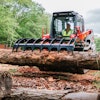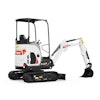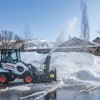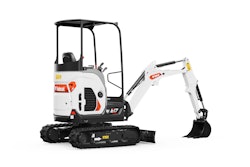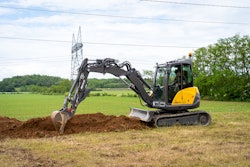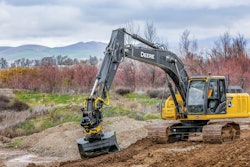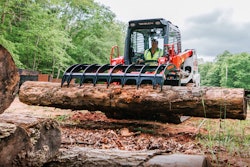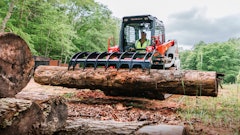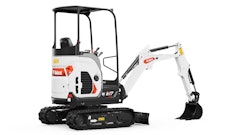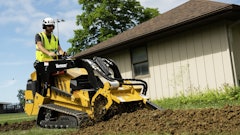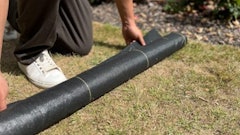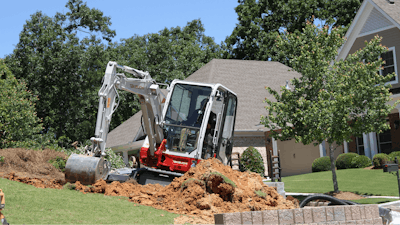
When installing hardscape features, contractors have choices in the equipment they use. Tractors, skid steers, track loaders and compact utility loaders can all help get tasks done more efficiently.
 Taking the time to do a little research will help you be more prepared to buy the correct compact excavator for the job resulting in more financial success.Kubota
Taking the time to do a little research will help you be more prepared to buy the correct compact excavator for the job resulting in more financial success.Kubota
In the end, it comes down to application. Understanding how different machines operate in landscaping applications is key.
A skid steer or tractor is best for load-and-carry work like spreading rock in a bed or when using pallet forks to pull retaining wall blocks off a truck. With a compact or mini excavator, you could be more precise.
“Compact excavators excel wherever they fit, offer versatility and fit in smaller spaces while providing optimal digging and lifting power,” says Justin Steger, solutions marketing manager, John Deere Construction & Forestry.
“Landscape professionals should talk to their local dealers not only about the right equipment, but also the dealer service and support for the job at hand to best determine the ideal machine for needed landscaping applications,” says Justin Steger, solutions marketing manager, John Deere Construction & Forestry.
“Compact excavators are ideally suited for rental, residential, landscaping, and utility applications,” says Patrick Baker, Kubota Tractor Corp. excavators and wheel loaders product manager. “This type of excavator excels at these jobs because there is little ground disturbance, and it can fit through fencing and gates.”
Picking the right excavator
There are a variety of factors that come into play when selecting which compact excavator model is right for the job.
“Customers need to consider if the specs match their current requirements such as width, dig depth, reach, lifting capability and suitability for hydraulic attachments,” Worley says. “Will their work applications stay consistent or are they going to require a larger machine in the near the future? Buy what is right and make sure it will suit your needs. Allow some room for expansion but do not over purchase by buying something that you do not need or will never use.”
Baker agrees, suggesting that buyers can narrow down and likely save money by doing some research and their “homework” before making a purchase.
“Taking the time to do a little research, the buyer will be more prepared to buy the correct compact excavator for the job resulting in more financial success in the long run,” he says.
Some of the primary considerations tie closely to questions landscapers need to ask themselves when choosing a mini or compact excavator.
“It is important to first determine your budget and what you can afford,” says David Caldwell, Takeuchi-US product manager. “Consider not only where your company stands today, but also where you see your company going in the future. As your company grows, you may discover the opportunity to provide additional services or work on larger projects that require a bigger, more capable excavator with a greater working range.”
Additional considerations include size and weight, what applications it will be used for, comfort and safety. A Cat 302 CR makes short work of a retaining wall or pile of rock materials.Caterpillar
A Cat 302 CR makes short work of a retaining wall or pile of rock materials.Caterpillar
One size fits all
“For landscapers who are primarily doing smaller residential jobs, a smaller machine from 2.5 to 3.5 ton may be adequate due to space limitations,” Caldwell says. “Those who work in larger residential areas or perform commercial work may want to consider a machine from 5-9 ton depending on the type of work they are doing.”
Operating weight is a factor to consider based both on site use and transportation.
“If you’re transporting the machine, operating weight will factor into your total weight, truck and trailer towing capability, and state licensing requirements,” Steger says. “Dig depth and attachment capability are the difference between a machine that can get the job done and a machine that can get the job done efficiently.”
There are number of differences when comparing specifications between a mini or compact and larger excavator.
“Compact excavators will have rubber tracks to reduce the footprint on the ground compared to steel tracks of larger excavators,” Baker says. “Also, compact excavators will also have a dozer blade capable of backfilling after trenching. The dozer blades are less common on large excavators.”
As another example, Baker says Kubota’s compact excavator boom swing function allows the operator to dig without repositioning the machine and is a function operators will not see on a large excavator.
Baker also says compact excavators are more likely to be reduced or minimal tail-swing to be more productive in those tight working areas compared to the large conventional tail-swing excavators.
“The bigger the machine, the more working range and capability it will have when lifting and placing objects, running hydraulically powered attachments and so on,” Caldwell says. “A retractable undercarriage can also be beneficial if they are having to access backyards through gates etc.”
Customers will also need to beware of the transport weight of the unit and how they are going to legally transport it.
“Moving and transporting compact excavators from job to job is easier and makes the compact excavator more versatile,” Baker says. Most are compatible with a wide variety of trailers and tow vehicles due to the lightweight and compact design.
Also, he says the industry has also seen a significant rise in telematics in compact excavators. “Owners and operators are able to reduce fuel costs, set geofences to protect their equipment from theft, and better maintain a service and maintenance schedule on their excavators,” Baker adds.
So many options
It’s important to determine the type of work you’ll be doing onsite to ensure the machine is properly equipped for your needs.
Due to their small size, mobility, and ability to use multiple attachments, working applications such as digging footers, irrigation, material handling, and landscaping are a great fit for compact or mini excavators.
“Compact excavator uses are endless,” Steger says. “They are great for trenching underground utilities, and using the standard backfill blade to cover the trench when the work is done, all with one machine and one operator. Compact excavators also provide reach and lifting capacity to work in hard to access areas.”
 Equipping the excavator with a bucket and thumb combo is a given for many in the landscape/hardscape industry professionals looking for easier ways to clean out trash and debris.Caterpillar
Equipping the excavator with a bucket and thumb combo is a given for many in the landscape/hardscape industry professionals looking for easier ways to clean out trash and debris.Caterpillar
“General purpose buckets and thumbs are by far the most utilized attachments among landscapers because of their added versatility,” Steger says. “Being able to pick and place objects rather than just scoop them up and dump with a bucket makes an operator much more precise and efficient whether it be in a demo or finish work application.”
In addition to the general-purpose buckets, grapples are ideal for picking and placing heavy objects like stones or railroad ties, or for cleaning up debris like limbs or logs.
“The number of attachments for excavators continues to grow every year because of the time saving efficiency they offer for a wide range of applications,” Baker says.
For example, Caldwell says outfitting the machine with a mower or mulcher makes it possible to clear unwanted brush, small trees and undergrowth, clean-up around ponds and keep paths and roads clear of overhanging branches.
In addition, landscapers often use augers to quickly drill holes for fence posts or planting vegetation on the job.
He says ditching/grading buckets feature a smooth edge and are ideal for ditch clean-out and grading or leveling areas in preparation for laying sod or installing a patio.
“Grading blades are a great tool and can be used to create various contours or slopes and level or grade areas to improve drainage and create more points of visual interest in the landscape,” Coldwell says.
“Customers are finding more and more uses for compact excavators, and these machines are now being treated more like a multitool,” Caldwell adds. “No longer are customers simply using a bucket and thumb; instead, they are finding ways to do a broader range of jobs smarter and more efficiently using the many attachment options available today “
Plenty of leg room
A comfortable operator is a productive operator.
Caldwell suggests when looking at purchasing or renting a compact excavator to consider the size of the operator area and how it is designed. Does it have a flat floor area with ample leg/foot space? Is there enough space between the joysticks so they do not contact the operator’s legs, limiting their stroke? How intuitive are the controls and monitor panel? Does the seat provide ample adjustments (fore/aft, weight, height)? If you know you’ll be working all year round, you may want to make the additional investment in a cab unit with heating and air conditioning.
He says contractors may also need their excavator to have a broader set of available auxiliary hydraulics so you can add additional implements and tools to get jobs done faster and more efficiently. “An excavator with the ability to set up multiple attachment presets makes it easier to switch between attachments and ensure that the excavator has the available auxiliary flow and capacity to run attachments efficiently,” Caldwell says.
Lastly, from a comfort standpoint, is determining whether you need an excavator with a cab or canopy.
“Keep in mind that while a cab unit may cost more initially, if it keeps you in the operator’s seat longer and for more months of the year, your increased productivity may pay for that additional investment very quickly,” Caldwell says.
In addition, the type of attachments being utilized should also be taken into consideration. Compact and mini excavators are ideal for landscape and hardscape applications for their small size and their ability to use multiple attachmentsTakeuchi-US
Compact and mini excavators are ideal for landscape and hardscape applications for their small size and their ability to use multiple attachmentsTakeuchi-US
For example, he says if the machine is going to be equipped with a breaker, a cab machine would provide the operator with greater protection than a canopy. The same would apply if using a mower or mulcher. A polycarbonate front glass/or window guard would also be needed to enhance or improve operator safety.
Additional safety considerations may be determined by site use. Caldwell suggests operators working in congested areas where there may be more foot or vehicular traffic should consider a rearview camera, especially on larger excavators where it would be more difficult to see around the rear of the machine. It is important to ensure that the travel alarm is operating properly on the machine to alert people around the machine that it is moving, even with the mini or compact excavators.
Should I just rent?
Deciding on whether to buy or rent a piece of equipment really is dependent upon the specific contractor and their individual business needs.
During more difficult economic times, having rental options allows customers to complete their project while conserving their cash flow and lines of credit.
“There is very little difference between our rental and retail models, so many of our contractors rent until they have enough guaranteed work before moving into the next stage of leasing or purchasing,” Worley says.
Several factors influence rental costs: demand, area, location in the U.S. (Western, Southeast, Northern, etc.), length of rental, and attachments and associated costs rented with the compact excavator.
“Whether a landscape professional is looking to rent or buy, customers usually always end up finding work for the machine,” Steger says. “Utilization is key to return on investment.”
 Moving and transporting compact excavators from job to job is easier and makes the compact excavator more versatile.John Deere
Moving and transporting compact excavators from job to job is easier and makes the compact excavator more versatile.John Deere
“If they will only need an excavator periodically, then renting a machine to complete a job or several jobs may suffice,” Caldwell says. “When renting a machine, contractors don’t have to worry about breakdowns or maintenance issues, depreciation, etc. They can opt for the newest, most feature-laden machine on the rental yard without worrying about how they’ll be able to afford it.”
However, the challenge is that they also may find that the machine they need is unavailable or out on another jobsite for an extended period.
“They lose a certain amount of control by renting,” Caldwell says.
Balancing the cost of renting per day or opting to rent for a month if the job is going to take three weeks is significant. Baker suggests going to the counter at the rental house and thoroughly examining the rental prices.
Delivery charges vary as well, depending on if the customer is physically picking up excavator at the rental yard or if the excavator is being delivered.
“The convenience of being able to continue to work on the job and have the excavator delivered to the jobsite may outweigh the cost of delivery & pickup,” Baker says. “By taking the time to examine and run the math while considering the length of time the excavator is needed, the renter may be able to save money and associated cost.”
However, as more people choose to work on property improvement projects, the demand for a contractor to purchase a mini excavator may be higher and over time the benefits are sure to pay off.
“If a contractor knows they’ll be doing a lot of work that a compact excavator and its attachments could handle faster and easier, the investment in a machine may be worth it because of the increased productivity it brings,” Caldwell says. “Consider how much time and effort you could save by investing in a compact excavator, will it help you complete more jobs and earn more revenue? If so, it could virtually pay for itself in a short period of time.”
There are also rental purchase options available for customers so they can rent the machine for a while and then purchase it later.
“Purchasers should do their research to better understand what exactly they need to get the job done before selecting a model,” Steger says.
He says it is imperative to always choose the model that best suits your needs. For example, Steger says each of the six John Deere models has different key specifications to consider when it comes to operating weight, dig depth, lift capacity, and attachments.
Also, whether purchasing or renting, Steger says customer support also should be a priority consideration. It is important to have dealer support for parts and service whenever needed.

